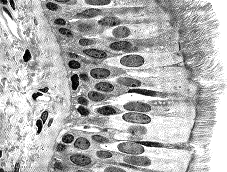The period following an action potential during which a neuron cannot be stimulated to generate another action potential is referred to as
A. the refractory period.
B. the threshold period.
C. the resting period.
D. the inactivation period.
E. the critical period.
A. the refractory period.
You might also like to view...
The ________ is all of the genetic material of a cell.
A. prophage B. chromosome C. genome D. plasmid E. proteome
The branch of genetics concerned with analyzing the structure and function of genes is
A) molecular genetics. B) plant genetics. C) transmission genetics. D) population genetics. E) applied genetics.
The type of tissue illustrated in Figure 39-1 is:

a. elastic connective tissue.
b. simple squamous epithelium.
c. pseudostratified epithelium.
d. cartilage.
e. adipose tissue.
Most individuals in academia are basic researchers, funded through research grants from agencies or foundations. Based on your knowledge of applied research, an industrial company would most likely employ individuals
A. who document fossils found in a specific archeological expedition. B. who identify a new species of beetle in the Amazon rainforest. C. who develop alternative fuel sources. D. looking at novel proteins involved in the development of a neurological disease.